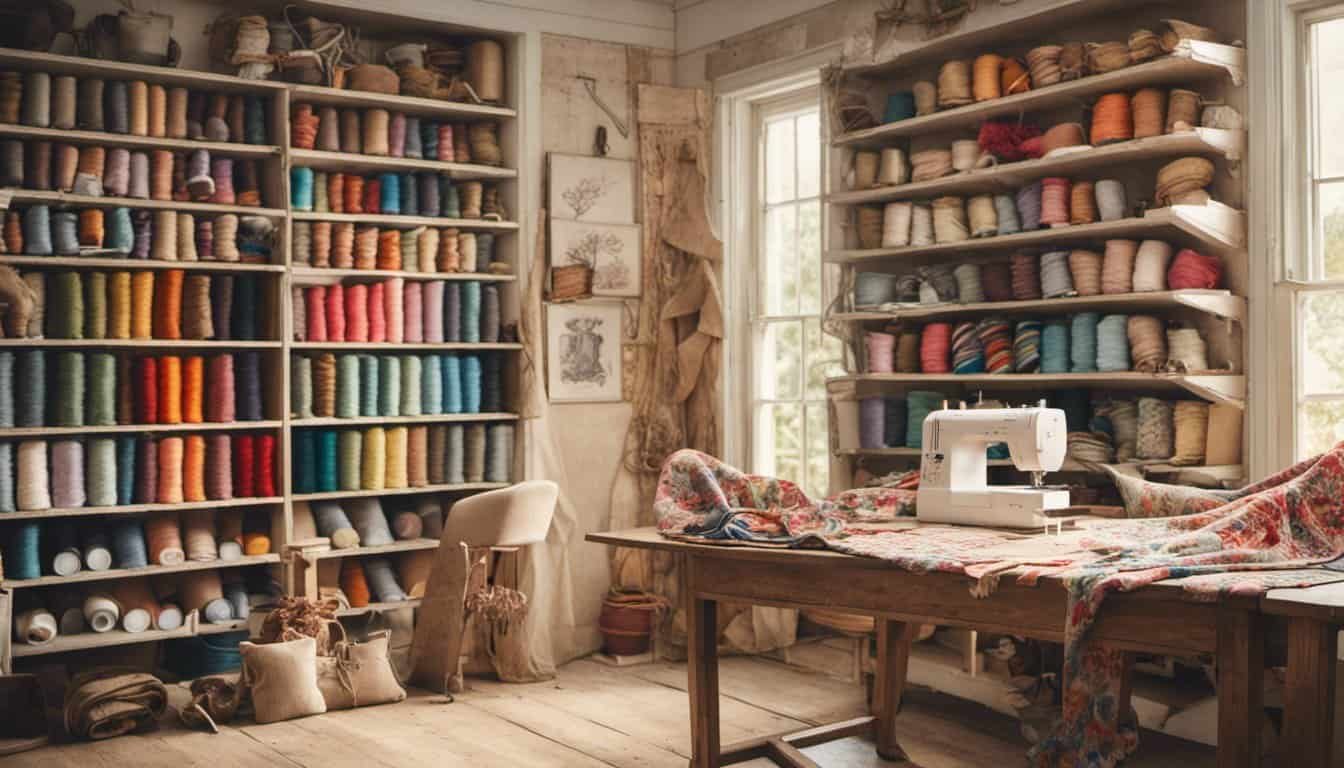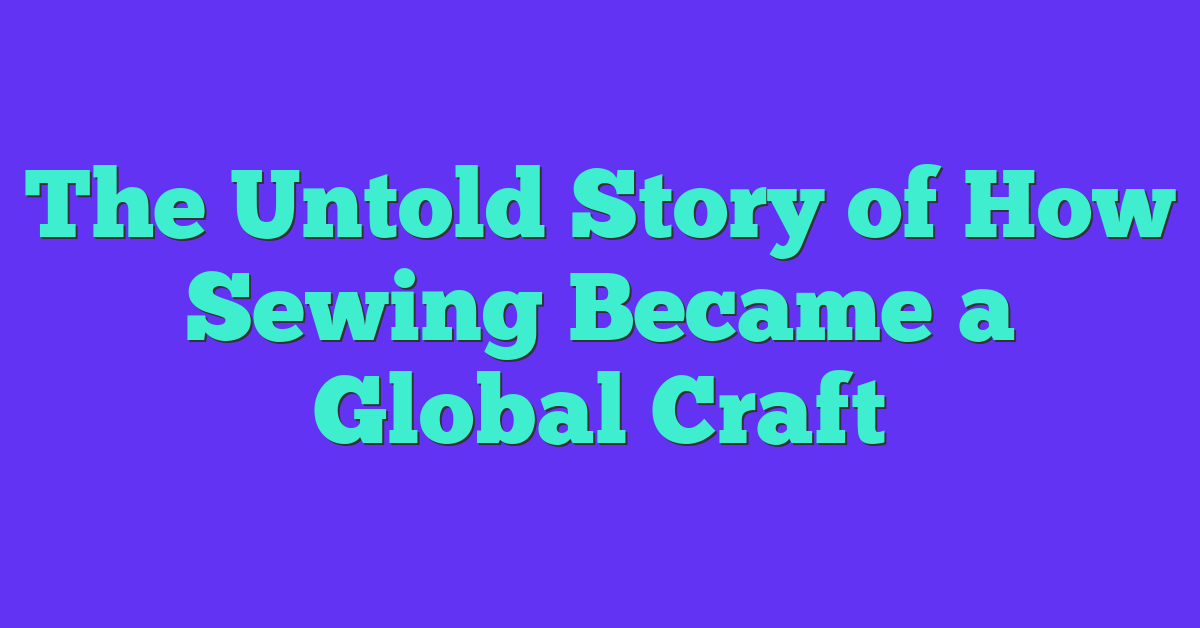Imagine walking through a bustling medieval marketplace where the vibrant colors of fabrics catch your eye. Sewing wasn’t just a skill back then; it was a cornerstone of daily life and culture. Whether you were crafting garments for yourself or contributing to the community, sewing played a vital role in shaping medieval society.
You might not realize how intricate and essential sewing was during this time. From the sturdy tunics of farmers to the elaborate gowns of nobles, each stitch told a story of craftsmanship and tradition. By understanding the role of sewing in medieval Europe, you’ll gain a deeper appreciation for the artistry and dedication that went into every piece of clothing and textile.
Dive into the fascinating world of medieval sewing and discover how this timeless craft influenced fashion, economy, and social structures. You’ll uncover the techniques, materials, and cultural significance that made sewing an indispensable part of life in the Middle Ages.
Historical Context of Sewing in Medieval Europe
Sewing played a crucial role in medieval Europe, intertwining with daily life, economy, and social hierarchies. You’ll find that clothing was a clear indicator of social status, with materials and embroidery distinguishing the nobility from commoners. Wool, linen, and later silk were primary fabrics, each chosen based on availability and rank.
Guilds regulated sewing professions, ensuring quality and training standards. Tailors, embroiderers, and embroiderers specialized in different aspects of garment creation. You may notice that monasteries also contributed, producing intricate tapestries and vestments for religious use.
Trade routes expanded access to diverse materials and techniques. Spices, dyes, and textiles from the East influenced European sewing practices, enhancing designs and colors. Urban centers like Florence and Paris became hubs for textile innovation, fostering craftsmanship that set fashion trends across the continent.
Economic factors dictated clothing production. Peasants crafted simple garments at home, while artisans produced more elaborate attire in workshops. You can observe that the demand for intricate sewing in the upper classes stimulated advancements in tools and methods, leading to more sophisticated embroidery and tailoring techniques.
Military needs also impacted sewing skills. Armorers and tailors collaborated to create protective yet flexible garments for soldiers. This collaboration ensured that clothing met both functional and aesthetic requirements, reflecting the era’s craftsmanship and practicality.
By understanding these historical elements, you appreciate how sewing in medieval Europe was more than a domestic task—it was a vital component of society’s structure and cultural expression.
Materials and Techniques Used
Understanding the materials and techniques used in medieval sewing reveals the craftsmanship behind the era’s garments and textiles.
Common Fabrics and Fibers
Medieval Europe featured diverse fabrics based on availability and social status:
- Wool: Accessible and versatile, wool was used for everyday garments by peasants and commoners.
- Linen: Derived from flax, linen was favored for undergarments and ecclesiastical vestments due to its smooth texture.
- Silk: Imported and luxurious, silk adorned the nobility’s attire, often embroidered with intricate patterns.
- Hemp: Utilized for sturdy clothing and sails, hemp provided durability for both daily use and military purposes.
- Fur: Incorporated into garments for warmth, fur signified wealth and was commonly used in outerwear by the upper class.
Sewing Tools and Equipment
Medieval sewists relied on specialized tools to create and embellish garments:
- Needles: Crafted from bone, wood, or metal, needles varied in size for different stitching purposes.
- Scissors: Made from iron or steel, scissors were essential for cutting fabrics with precision.
- Looms: Used for weaving textiles, looms ranged from simple hand-operated models to more complex designs in urban centers.
- Thimbles: Protecting fingers, thimbles were worn while hand-sewing to prevent injury.
- Embroidery Hoops: These held fabric taut, allowing for detailed embroidery work on garments and tapestries.
- Spindles and Bobbins: Essential for spinning and managing threads, these tools facilitated the creation of yarn from raw fibers.
- Sewing Frames: Early versions of mechanical sewing devices, sewing frames increased efficiency in textile production within guilds and workshops.
These materials and tools not only supported daily clothing needs but also enabled the creation of elaborate designs that reflected social hierarchy and cultural values in medieval Europe.
Social and Economic Significance
Sewing played a crucial role in shaping medieval European society and economy. It influenced social structures, economic practices, and daily life.

Role of Women in Sewing
Women dominated the sewing landscape in medieval Europe. They managed household garments, ensuring clothing was practical and stylish. Skills varied by class, with noblewomen embroidering intricate designs and peasant women focusing on durable fabrics. Sewing knowledge passed down through generations, reinforcing family traditions and roles. Women’s expertise extended beyond clothing, including tapestries and household textiles, essential for both domestic life and social status.
Sewing as a Trade and Craft
Sewing thrived as a regulated trade and skilled craft. Guilds controlled training, quality, and prices, maintaining high standards across regions. Artisans specialized in areas like tailoring, embroidery, or textile production, fostering innovation and craftsmanship. Economic activities included local production and long-distance trade, especially in luxury fabrics like silk. Sewing contributed significantly to urban economies, with centers like Florence and Paris becoming hubs for textile artistry. This specialization not only supported local markets but also facilitated cultural exchanges through trade routes, enhancing medieval Europe’s economic resilience and diversity.
Clothing and Fashion
Clothing in medieval Europe mirrored social structures and cultural values. Your wardrobe reflected your status, occupation, and regional influences.
Everyday Attire
Commoners typically wore garments made from wool and linen. Men donned tunics paired with hose, while women wore simple dresses with aprons. Peasants favored durable fabrics for everyday tasks, ensuring practicality and comfort. Colors remained subdued, with undyed wool in natural hues dominating daily wear. Footwear included sturdy leather shoes or boots, suitable for agricultural work and daily chores.
Noble and Royal Garments
Nobles showcased their status through luxurious fabrics like silk and fine wool. Men wore elaborate doublets and hose, often embellished with embroidery or fur trim. Women’s gowns featured rich textures, intricate patterns, and lavish decorations such as jewels and metallic threads. Sumptuary laws regulated colors and materials, reserving certain hues like purple and gold for the aristocracy. Cloaks and mantles adorned with embroidery and fur lined armor complemented their attire, emphasizing wealth and power in court and ceremonial settings.
Religious and Cultural Impacts
« Unlock Your Sewing Potential: Discover the Top 10 Podcasts You Can’t Miss in 2025
You Won’t Believe How Easy It Is to Make a Scrappy Quilt from Leftovers »
Sewing significantly influenced religious practices and cultural expressions in medieval Europe. It shaped both the spiritual and everyday lives of people, reflecting deeper societal values.
Liturgical Vestments
Clergy members wore intricate liturgical vestments, essential for religious ceremonies. These garments included chasubles, stoles, and albinas, crafted from fine fabrics like silk and adorned with elaborate embroidery. Monastic communities produced vestments with motifs symbolizing religious themes, ensuring each piece met strict ecclesiastical standards. Guilds specialized in ecclesiastical sewing, maintaining quality and consistency across regions. The production of vestments reinforced the church’s authority and facilitated uniformity in religious attire across different dioceses.
Symbolism in Clothing
Medieval clothing embodied social status and cultural identity through symbolic designs and materials. Nobles favored rich fabrics such as velvet and brocade, often embellished with gold thread and gemstones to signify wealth and power. Commoners wore simpler garments made from wool or linen, reflecting their social standing. Colors held specific meanings; for instance, purple denoted royalty, while green symbolized fertility and growth. Embroidery patterns often depicted regional folklore or religious iconography, connecting individuals to their heritage and beliefs. Sumptuary laws regulated these symbols, ensuring that clothing consistently represented the wearer’s societal role and cultural affiliations.
Technological Advancements
Technological advancements significantly shaped sewing practices in medieval Europe. These innovations enhanced efficiency and expanded creative possibilities.
Innovation in Sewing Techniques
Medieval sewists developed advanced stitching methods to improve garment durability and aesthetics. Techniques such as chain stitch, satin stitch, and herringbone provided strength and decorative appeal. Embroidery became more intricate, incorporating patterns like fleur-de-lis and geometric designs. Tailors mastered tailoring techniques, enabling the creation of fitted garments that accommodated movement and varied body shapes. Buttonholes and lacing systems were introduced, allowing for adjustable and secure closures in clothing. These innovations not only increased the functionality of garments but also allowed for greater expression of social status through detailed craftsmanship.

Influence on Textile Production
Advancements in sewing techniques directly impacted textile production, leading to higher quality fabrics and diverse textile products. The introduction of improved loom technology increased fabric production speed and consistency. Spinning tools like the Saxony spindle enhanced yarn strength, facilitating the creation of finer threads for detailed embroidery. Dyeing methods became more sophisticated, producing a wider range of vibrant and long-lasting colors. The integration of specialized tools, such as embroidery hoops and tailor’s rulers, streamlined the production process, enabling greater precision. These technological improvements supported both domestic sewing practices and the commercial textile industry, fostering economic growth and cultural exchange across medieval Europe.
Regional Variations
Sewing practices in medieval Europe differed significantly across regions, influenced by climate, available materials, and cultural exchanges. These variations shaped the distinct textile traditions found in Northern and Southern Europe.
Northern Europe
In Northern Europe, wool dominated the textile industry due to the favorable climate for sheep farming. Common wool types included coarse for everyday garments and fine wool for higher-status attire. Linen was also prevalent, especially for undergarments and household textiles. Embroidery featured geometric patterns and simple motifs, reflecting the practical aesthetic of the region. Guilds in cities like London and Hamburg regulated sewing standards, ensuring quality craftsmanship. Trade with the Hanseatic League introduced advanced techniques and materials, enhancing local sewing practices.
- Primary Fabrics: Wool, linen
- Common Techniques: Geometric embroidery, simple stitching
- Key Centers: London, Hamburg
- Influences: Hanseatic League trade routes
Southern Europe
Southern Europe showcased a diverse range of fabrics, including silk, which highlighted wealth and sophistication. The Mediterranean climate supported the cultivation of flax and the raising of silkworms, contributing to the abundance of linen and silk textiles. Embroidery in regions like Florence and Venice became highly intricate, featuring floral motifs and elaborate designs influenced by Byzantine and Islamic art. Tailors in these areas specialized in creating luxurious garments for the nobility, utilizing techniques such as gold threading and appliqué. Trade with the Byzantine Empire and the Islamic world introduced vibrant dyes and advanced sewing methods, fostering a rich textile culture.
- Primary Fabrics: Silk, linen, flax
- Common Techniques: Floral embroidery, gold threading, appliqué
- Key Centers: Florence, Venice
- Influences: Byzantine and Islamic art, Mediterranean trade
Comparison Table
| Aspect | Northern Europe | Southern Europe |
|---|---|---|
| Primary Fabrics | Wool, linen | Silk, linen, flax |
| Common Techniques | Geometric embroidery, simple stitching | Floral embroidery, gold threading, appliqué |
| Key Centers | London, Hamburg | Florence, Venice |
| Influences | Hanseatic League trade routes | Byzantine and Islamic art, Mediterranean trade |
Conclusion
Sewing was more than just a daily task in medieval Europe. It shaped communities and connected people through shared traditions and craftsmanship. Your appreciation for textiles today can trace back to those skilled sewists who balanced practicality with artistry.

Understanding the role of sewing offers a window into the social structures and economic dynamics of the time. It highlights how something as simple as a stitch could signify status and foster innovation. Embracing this history enriches your perspective on the enduring legacy of medieval craftsmanship in our modern world.

















